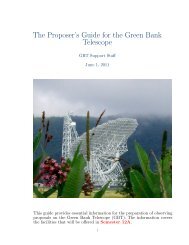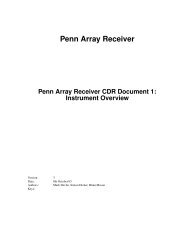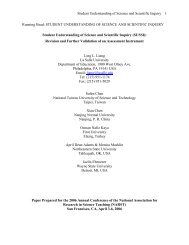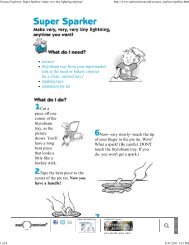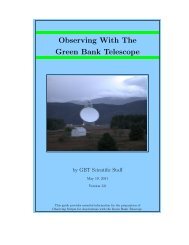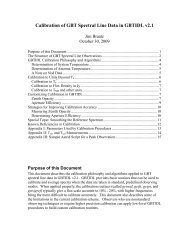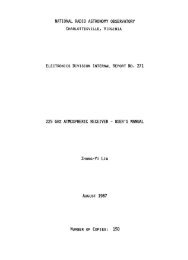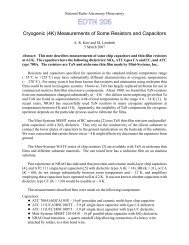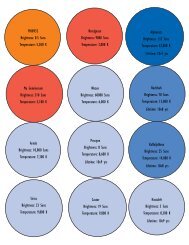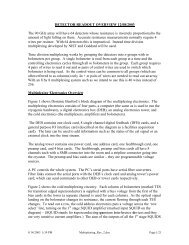185 - National Radio Astronomy Observatory Green Bank
185 - National Radio Astronomy Observatory Green Bank
185 - National Radio Astronomy Observatory Green Bank
You also want an ePaper? Increase the reach of your titles
YUMPU automatically turns print PDFs into web optimized ePapers that Google loves.
NATIONAL RADIO ASTRONOMY OBSERVATORY<br />
GREEN BANK, WEST VIRGINIA<br />
ELECTRONICS DIVISION TECHNICAL NOTE NO. <strong>185</strong><br />
Title:<br />
Authors:<br />
SIX BAND FEED HORN PROPERTIFS AT 2025 TO 2120 MHZ and<br />
S-BAND FEED SYSTEM TUNING PROCEDURES<br />
George Behrens, Gary Anderson, Galen Watts and Glen Langston<br />
Date: November 15, 2000<br />
DISTRIBUTION:<br />
GB CV TU VLA<br />
GB Library ER Library Library-Downtown VLA Library<br />
G. Anderson IR Library M. Brooks AOC Library<br />
E. Childers R. Bradley J. Chon g L. Abeyta<br />
R. Fisher C. Burgess L. D' Addario R. Armendariz<br />
J. Ford J. Effland J. Fitzner B. Broil°<br />
R. Lacasse R. Escoffier R. Freund J. Cheng<br />
R. Norrod N. Horner F. Gacon T. Cotter<br />
D. Parker A. R. Kerr V. Gasho P. Dooley<br />
D. Schiebel S.- K. Pan W. Grammar S. Durand<br />
A. Shelton G. Petencin E. g einp R. Ferraro<br />
M. Stennes M. Pospieszalski J. Kingsley R. Hayward<br />
G. Watts S. Srikanth F. Meadows J. Jackson<br />
T. Weadon D. Thacker G. Moorey C. Janes<br />
S. White J. Webber J. Payne W. Koski<br />
A. Perfetto R. Latasa<br />
M. Pokorny P. Lewis<br />
S. Radford R. Molina<br />
G. Reiland G, Peck<br />
B. Shillue M; Revnell<br />
D. Urbain N. Rhodes<br />
A. Vaccari J. Ruff<br />
L. Serna<br />
G. Stanzione<br />
W. Thunborg<br />
R. Weimer<br />
(11-00)
SiX Feed Horn Properties at 2025 to 2120 MHz<br />
1<br />
and<br />
S Band Feed System Tuning Procedures<br />
George Behrens, Gary Anderson, Galen Watts and Glen Langston<br />
00 November 15<br />
Overview<br />
This document describes measurements of the <strong>Green</strong> <strong>Bank</strong> Interferometer and 20 m antenna SiX<br />
band feed horn at the NASA S-Band Uplink frequencies. These measurements were made to<br />
determine the suitability of this horn for use in a Satellite communications design. The S band<br />
portion of the horn is dual circularly polarized and was designed to operate well in the 2200 to 2400<br />
MHz range, which includes the Satellite Downlink frequency range. Test data were needed in the<br />
2025 to 2120 MHz range to determine the feed horn beam shape, polarization purity and isolation.<br />
The NASA standard S band Uplink band is 2025 to 2120 MHz and by convention the satellite<br />
downlink is phase locked to the uplink frequency with turn around ratio 240/221. The downlink<br />
frequency range is 2200 to 2300 MHz. For the Japanese Halca Satellite, the uplink frequency is<br />
2084.4 MHz and the downlink frequency is 2263.6 MHz. Measurements indicate that the feed horn<br />
is suitable for use in the frequency range 2025 to 2120 MHz. The feed horn components were tuned<br />
for improved performance in the transmit band.<br />
Test Setup<br />
The measurements were made on the NRAO <strong>Green</strong> <strong>Bank</strong> mtitenna range using a linearly polarized<br />
feed horn and also using two conical helix antennas. At the transmit horn an HP synthesizer was<br />
tuned to frequencies in the S band uplink range and power output was set to +10 dBm. A 20 dB<br />
directional coupler was used at the transmit horn to provide the Scientific Atlanta test receiver with<br />
a phase stable reference frequency.<br />
The test receiver was located at the base of the tower holding the feed. The test receiver was locked<br />
to the transmit frequency and generated a LO frequency that was equal to the reference frequency<br />
plus or minus 45 MHz. The test signal received by the feed system mixed with the receiver L.O.<br />
signal at a coaxial mixer connected to one of the Orthomode Transducer (0MT) ports. The mixer<br />
down converted the received frequency to 45 MHz. The test receiver was used to measure the<br />
amplitude and phase of the received signal. The test receiver is somewhat difficult to adjust, so<br />
care was taken to adjust the signal levels to maintain proper lock of the test receiver.
SIX Band horn tests at NASA S-Band Up Link Frequencies Page 2<br />
Transmit Isolation Isolation Axial<br />
Frequency Helix 445 Helix 442 Ratio<br />
(MHz) (dB) (dB) (dB)<br />
2025 -11 -17.3 4.6<br />
2050 -15 -16.0 3.7<br />
2083 -8<br />
2100 -9 -8.4 2.6<br />
2120 3.0<br />
2210 -16 -20.0 0.9<br />
Beam Pattern Measurements<br />
Table 1: Measurements of Polarization Isolation and Axial Ratio<br />
The amplitude and phase beam patterns were made for the forward OMT port of the horn in both<br />
the E and H planes. The forward feed OMT port was determined to be the RCP port, using the<br />
LCP polarized helix feeds. (Note that for RCP uplink transmissions, the LCP polarized, rear, port<br />
will be used, when the feed is at the antenna prime focus.) The beam patterns for a number of<br />
frequencies in the band are shown in figures 1 to 10. The measurements at 2210 MHz, shown in<br />
figures 9 and 10, were performed to confirm the measurement process, by comparing the results<br />
with previous measurements. The new measurements were found to agree with the previous data.<br />
The polarization Isolation and Axial Ratio were measured and listed in table 1. A number of<br />
repetitions of the Isolation measurements were made due to inconsistency in the measurements. It<br />
was finally determined that the Helix feed serial number 445 from American Electronic Laboratories<br />
had poor properties in this frequency range. Helix feed serial number 442 from the same<br />
manufacturer was used and found to give more consistent results. The measurements of Table<br />
1, Helix 442 results are considered most reliable. The Axial Ratio measurements were made using a<br />
rotating linearly polarized transmitting feed horn. The Axial Ratio was determined by measuring<br />
the difference between maximum and minimum received signal level as the polarized transmitting<br />
horn was rotated ±180 degrees.<br />
Return Loss and Isolation Measurements<br />
Measurements of return loss and isolation were made in the lab, using a network analyzer. The<br />
test setup placed the transmit signal on the rear port, and the isolation was measured on the front<br />
port. The return loss of the OMT ports could be adjusted by changing the iris width at the ports.<br />
The S band feed horn transition includes a metal "tuning ring" mounted inside a Polystyrene Foam<br />
Support (PFS). Adjustment of this ring, by moving the PFS in and out, allowed improving the<br />
polarization isolation in different frequency ranges.<br />
The measurements of the return loss and polarization isolation in the frequency range 2000 to<br />
2500 MHz are are shown in figures 11, 12, 13 and 14. In figure 11, the feed is in the unmodified<br />
configuration. The return loss measurements match reasonably well with previous data, however<br />
the polarization isolation is very fiat at about -10dB, somewhat poorer than was shown in previous
SIX Band horn tests at NASA S-Band Up Link Frequencies Page 3<br />
measurements in the 2200 to 2300 MHz region.<br />
In figure 12, the same data were taken with the matching iris in the rear port widened from its<br />
initial 2.25 inch width to 3.28 inches, in order to improve the return loss in the transmit band. The<br />
return loss is significantly improved in the transmit band, being no worse than -12.4 dB, but the<br />
receive band shows between -8.8 and -6.3 dB return loss. The isolation in this configuration is not<br />
significantly modified.<br />
In figure 13, the iris is returned to the original configuration, but the PFS containing the tuning<br />
ring was moved back 2.51 inches from the front surface of the X band horn. In this configuration,<br />
the return loss remains high, -5.4 to -8.4 dB in the transmit band, but the polarization isolation is<br />
improved to between -14.3 and -21 dB.<br />
In figure 14, the wide rear port iris was used in conjunction with the repositioned tuning ring.<br />
Both the isolation and return loss are improved in the transmit band. The return loss is between<br />
-12.5 and -22 dB and the isolation is between -12.4 and -15.5 dB. The return loss is worse that the<br />
original configuration in the downlink band, between -15.5 and -9.3 dB but the isolation is much<br />
improved, between -23 and -13.7 dB. The measurements of isolation shown in figure 14 are similar<br />
to the measurements made immediately after the feed was constructed.<br />
Satellite applications will use narrow up and down link bandwidths (> I MHz), the return loss and<br />
isolation parameters can be tuned to yield good properties at specific link frequencies. In the fully<br />
tuned configuration (figure 14), for the HALCA uplink the return loss is -21 db and the isolation is<br />
-13 dB. For the HALCA downlink, the return loss is -12 dB and the isolation is -18 dB.<br />
In figure 15, the return loss and isolation are shown with the tuning ring adjusted for maximum<br />
polarization isolation in the uplink band. Notice that although the isolation in the uplink band is<br />
improved to better than -17 dB, the isolation in the downlink band has degraded to between -12<br />
and -8 dB.<br />
Conclusions<br />
The amplitude and phase beam patterns at frequencies in the range 2025 to 2210 MHz were<br />
symmetric and showed proper shape in the range ±60 degrees.<br />
Measurement of return loss and isolation in the laboratory indicate that the S band horn tuning<br />
ring had shifted from its original position. Readjustment of the tuning ring and modification of the<br />
rear port iris yielded much improved performance. The placement of the tuning ring and size of<br />
the iris opening should be matched to the specific up and down link frequencies of the mission.
SIX Band horn tests at NASA S-Band Up Link Frequencies Page 4<br />
Appendix A: Procedure for tuning the S/X Feed<br />
The following are some recommendations and comments regarding the tuning of the SiX Feeds<br />
that are presently installed at the GB Interferometer, the 20 Meter Telescope and the one that was<br />
installed on the the telescope in Kokee Park, Hawaii. The tuning is performed by first calibrating a<br />
network analyzer then attaching the forward OMT port to the transmit side of the network analyzer<br />
and attaching the rear OMT port to the receive side.<br />
Please refer to Figures 2 and 3 of the report that appeared in the Proceedings of the IEEE of May<br />
1994 entitled "Design and Implementation of a Low-Noise Prime Focus S/X Receiver System for<br />
<strong>Radio</strong> <strong>Astronomy</strong>" , by Roger D. Norrod, George H. Behrens, Jr, Frank D. Ghigo and Burton J.<br />
Levin. These figures are included here as Figures 16 and 17.<br />
As shown in Fig. 16, the S-Band section of the Feed is composed of items 1 through 12. A<br />
description of these components is given in the paper_ However, a review of their purpose and<br />
interaction is given here as an aid to understanding the tuning procedure.<br />
The S-band Section of the S/X Feed System consists of three sub-assemblies- 1) the Feed, 2) the<br />
Polarizer and 3) the Orthomode Transducer (0MT).<br />
The Feed:<br />
The Dual Depth Corrugated horn (Item 1), is excited by the Coaxial Waveguide (item 5) where the<br />
X-Band wave:guide (Item 14) serves as the center conductor of the S-Band waveguide.<br />
Impedance matching of the Corrugated Horn to the Coaxial Waveguide is achieved by the tuning<br />
ring (Item 3) which is held in place by the Polystyrene Foam Support (PFS).<br />
The Polarizer:<br />
The S-band Polarizer (Item 6) is comprised of two cross-linked polystyrene plates that also act as<br />
supports for the X-Band Waveguide. The length of the polarizer is such that it provides a differential<br />
phase shift of approximately 90 degrees for waves that have E-Fields parallel and perpendicular to<br />
the polarizer plates.<br />
Impedance matching of the polarizer to the circular waveguide is achieved by the steps milled on<br />
the ends of the polystyrene plates.<br />
The Polarizer plates are oriented such that the E-fields excited by the two Orthogonal Slot Coupled<br />
T-Junctions (Items 7 and 9) are rotated 45 degrees with respect to a plane pa:raliel to the polarizer<br />
plates. Such orientation causes that component of the E-field parallel with the Polarizer plates<br />
to lag that component that is normal to the plates by 90 degrees-the criteria required for circular<br />
polarization.
SIX Band horn tests at NASA S-Band Up Link Frequencies Page 5<br />
The Orthomode Transducer (0MT):<br />
The S-band OMT Sub-Assembly, is comprised of Items 7 thru 12. The Forward Slot coupled T-<br />
Junction (Item 7) couples energy from the S-Band WR-430 Waveguide to the Coaxial Waveguide.<br />
Item 7 is oriented with respect to the Polarizer Plates to provide Right Circular Polarization at<br />
the Feed. Similarly, the Rear Slot Coupled T . -Junction is oriented with respect to the Polarizer to<br />
provide Left Hand Circular (LHC) at the Feed.<br />
The Septum (Item 8) acts as a back short for the Forward Junction and channels RHC energy<br />
received by the Feed to the RHC WR-430 waveguide. As RHC energy propagates down the coaxial<br />
waveguide it is converted to a linear polarized wave by the polarizer. The polarization of the E-Field<br />
is such that it is parallel to the septum and therefore is reflected back towards the feed. However<br />
since the septum is located approximately 1/4 wavelength beyond the Forward Junction, it appears<br />
as a high impedance as seen at the junction and little energy propagates beyond the junction.<br />
Essentially all the energy is then coupled to the the RHC rectangular waveguide.<br />
In the case of LHC energy received by the Feed, the polarizer converts the circularly polarized signal<br />
such that its E-Field is oriented normal to the Septum and therefore the Septum appears essentially<br />
transparent to the signal. The signal then propagates to the Rear T-Junction (item 9) where it is<br />
coupled to the LHC WR-430 waveguide after being reflected at Back Short (Item 10).<br />
Tuning of the feed system over a limited frequency range is achieved by setting the feed impedance<br />
match and the OMT match.<br />
S-Band Feed System Tuning Procedures<br />
Feed Impedance Match:<br />
As mentioned above, the S-Band Feed is matched to the Coaxial waveguide by adjusting the<br />
dimensions and position of the Tuning Ring (Item 3) which is held in place by the Foam Support<br />
(Item 4). During the original tuning of the Feed it was optimized over the 2.2-2.3 GHZ Band. The<br />
dimensions and position of the Tuning Ring was determined empirically by measuring the Isolation<br />
between the RHC Coupler (Item 7) and the LHC Coupler (Item 9). The dimensions of the Tuning<br />
Ring and its position were changed until maximum isolation was obtained.<br />
It is assumed that the feed is optimally matched under this condition because when the test signal<br />
is injected into the RHC Coupler and propagates thru the polarizer it gets converted to a RHC<br />
polarized signal. This RHC signal continues to propagate to the feed. If the feed is perfectly matched<br />
all the energy will be propagated into free space. However if the Feed is not perfectly matched, a<br />
portion of the test signal will be reflected at the Throat of the Feed (the Feed/Circular Waveguide<br />
Interface). Since reflections of Circular Polarization signals are converted to the opposite sense, the<br />
reflected portion of the RHC test signal becomes a LHC signal and appears at the LHC (Rear)<br />
Coupler. Hence, the Isolation measurement is directly related to how well the feed is matched.<br />
If the Feed is to be matched for a specific frequency, measure the isolation between the RHC and<br />
LHC Couplers and slide the Foam Support which houses the Tuning Ring until maximum isolation
S/X Band horn tests at NASA S-Band Up Link Frequencies Page 6<br />
occurs over the desired band. Measure the Isolation using the Network Analyzer in the Dual Channel<br />
Mode so that both Return Loss and Isolation can be observed simultaneously. Ensure that when<br />
adjusting the tuning ring, that there is little change in Return loss and that S12 is the same as S21<br />
and that the Return Losses Sll and S22 are similar.<br />
OMT Matching:<br />
The RHC and LHC Couplers are matched to the WR-430 Rectangular Waveguide by empirically<br />
adjusting the back short (10), the Septum (Item 8), and Tuning Irises (Items 11 and 12).<br />
In the original development of the OMT, the OMT was terminated with a sliding Coaxial Waveguide<br />
Load. The Network Analyzer was calibrated in WR-430 waveguide and the Admittance looking<br />
into the RHC port was measured for different positions of the Septum. The Reference plane during<br />
calibration was the junction of the WR-430 waveguide and the RITC Coupler. The Septum position<br />
was adjusted to cause an admittance locus that could be tuned by using a Inductive Iris at the<br />
Junction or at some point away from the junction and inside the WR-430 Waveguide. The width<br />
of the Iris was adjusted to obtain the best match over the 2.2-2.3 GHZ Band.<br />
The LHC Port (Rear Port) was tuned in a similar fashion except that the Back short was adjusted<br />
instead of the Septum. A location of the Septum was found that would permit a Shunt Inductive<br />
Iris in the WR-430 waveguide that would optimally match the LHC Port over the 2.2-2.3 GHZ<br />
Band.<br />
If the OMT is to be tuned for another Band, it is recommended that the total feed system be<br />
connected and that the Network analyzer be calibrated for a Full Two Port Measurement. Connect<br />
the Network analyzer to both ports and measure simultaneously the Return Loss (S11) and Isolation<br />
between the RHC and LHC Port (S12) by using the dual channel mode on the network analyzer.<br />
Vary the width of the window to obtain the best Return Loss and observe S12 to ensure there is no<br />
interaction. Wider openings in the window of the iris will permit lower frequency operation.
.<br />
SIX Band horn tests at NASA S-Band Up Link Frequencies Page 7<br />
E and H plane measurements at 2025 MHz<br />
f.3 dUverif div).<br />
.1r...<br />
(: iuert. thy) 24<br />
:<br />
. I<br />
. , .<br />
2<br />
f- ... 1 .<br />
-- 1 . :.<br />
•<br />
• - :$ "-- - •<br />
11111111111.11frt . - : I<br />
i i .-.'. - : : --- --- - .<br />
.....1.-- ' .<br />
: :. :<br />
. , . ,<br />
i<br />
111111M<br />
‘ I 1<br />
: - -<br />
• ; :. ; ---.-; - i ; -. - - i . i<br />
, :<br />
i t : -3 . .. i. . - 1 i<br />
. V . I t<br />
' . F. I--<br />
; I A .1 .<br />
,.`<br />
I . M.,..: . .<br />
i -. . i t /. 1 '<br />
i<br />
.. 1 t<br />
•<br />
.<br />
1 4 2<br />
t - ' .-..<br />
: . . . . .. . !<br />
. , I , i - i - . •<br />
-Sṯ<br />
9e -es -10 .<br />
-<br />
•<br />
, 1 . . i I -. 1<br />
FOCQS RIHE<br />
p<br />
Va0 'SX = Pnd<br />
commas.<br />
. -- I .. '<br />
,<br />
....<br />
-,<br />
• 1 it I . . . ' .- • % 1 -<br />
IIMMEIMISBNIIIIII$<br />
; 1 • • • i 1<br />
, -- -<br />
i ; I I l .: - f-<br />
1111•1111111111111111111111111<br />
• ; I i 1 1 . . 1<br />
• • ; ; :<br />
: : .<br />
deg<br />
•11111111111•M 111 1 ' .; ! f<br />
-- 1 I i i - i -<br />
i - • -- : ,<br />
111111111.11•1•111111111.11M<br />
-124<br />
611' , -46 -1 g 2o 36 - 4e '94<br />
.se<br />
:<br />
RIPON C Laidig<br />
X-Wi5 . pe hition'=.4.000-inces<br />
tAtE i • leiatsw<br />
EDGE WK.:<br />
MIGHT .s5<br />
. -4b( is p eis t ictil - Areivis<br />
e13: t6<br />
Figure 1: S Band Horn Amplitude and Phase versus orientation relative to linearly polarized horn E plane.<br />
A<br />
ga<br />
< 411/tiert. div)<br />
:<br />
/siert. thy) 24<br />
... ,<br />
. „<br />
: , -<br />
i ,,i<br />
1<br />
'' .<br />
'<br />
. '<br />
'<br />
•<br />
1,. ' \ s I<br />
•<br />
t........A.V............i.,<br />
,<br />
.<br />
• ,<br />
' : .. ,<br />
•<br />
,<br />
F.. ....<br />
,<br />
:. '<br />
5<br />
— 0:44<br />
:- ,---<br />
, L.,f<br />
„4......••4...<br />
:-<br />
'<br />
--A---}- . 4<br />
-<br />
i, ; I.:. ..- 1 -,,,,<br />
+ -4-144---i--..<br />
1 : ,-- 1<br />
.5g<br />
-90 -90 -70 -E.0 -50 -48 ---2e -to<br />
cattmi<br />
piatu = PAM<br />
FEED = DX Feed<br />
UmENIS :<br />
Tat=4-.2.0<br />
X-Hx positim) = felee iochel<br />
BRIE //MAO<br />
.<br />
i .-<br />
- -<br />
1 T-17---,<br />
— ----+-----<br />
'<br />
, •<br />
:<br />
1._—_<br />
,I..__.L__44_4___1......4<br />
.. . , i - - :<br />
:: - : • .,, , A, . , : , ......<br />
I<br />
......... ..<br />
. a; -... .:1<br />
-- i f: i•<br />
i<br />
; ‘.,---<br />
,<br />
..,<br />
.. ; •<br />
-.-<br />
.<br />
..<br />
: :<br />
,<br />
. , !<br />
.<br />
, .,<br />
i<br />
•: ,:<br />
,<br />
ti<br />
S<br />
f I . ....,...... ...........1 ..,..,+.............<br />
-: ,<br />
deg<br />
i------i-----1----4<br />
'<br />
...1___1 _1____ 1.„1,<br />
te 2e 30 4 5<br />
iftmtv<br />
-4.8a<br />
:<br />
al 78 sa<br />
Y-oxis positicm +c on inches<br />
TIM : 00:24<br />
Figure 2: S Band Horn Amplitude and Phase versus orientation relative to linearly polarized horn H plane.<br />
-e.2s<br />
-24
six Band horn tests at NASA S-Band Up Link Frequencies Page 8<br />
E and H plane measurements at 2050 MHz<br />
4'<br />
J (3 cflitopi.. div) (3<br />
del / Vert. dim} 24<br />
eq !,<br />
1<br />
' : " ■ , i : - I ',., . !, '. ,<br />
—Jt........;41........4.........4.. ...; .' ......1./.....1 • • 1 .<br />
' •-:iiis.......4.,,4,<br />
2 • ;• I ; 1 ' • ,. 1" • ''. . I1 i• i<br />
: 1<br />
4 ... I'<br />
7' .---1---4--1'<br />
F--",---<br />
,.<br />
• . :<br />
i 1,<br />
'Li i 1<br />
.-4—•,•••4,..4A.44th..44.,w.a..alr,,,...o.....4—.........i. —......4,---..,,:<br />
, ,.4.., i<br />
i 4 1 .: I a:<br />
: 1 * 1 .<br />
, ; 1 1 . . \ 1 •<br />
, : : , : , • , ;<br />
--...--t......................;•••,...• ". :<br />
--............1..........t..... 4 -<br />
. ; :: . ,, • i I<br />
. ..........i.<br />
,<br />
r1+.........i....<br />
!4 i :<br />
i 1<br />
: :S.<br />
".• t ''' 1 - I ; . .<br />
. • • •<br />
i . '.• 1 i l' 1 i ,r.<br />
: Z■.•■.,•1 ,. 4.•••••• .4 • 44.4,4. •I• • ■ •<br />
: i ..q's :,. " 1 i . ■ . •<br />
....WI..<br />
.. ! 4.<br />
1 : , I . fi , - i , i 1<br />
. : ! I .. , i i i - - 1 : I<br />
1 1-.........- ..........1.4,..44,44,44,1!......., . . . - f .<br />
1,<br />
:: , .: : i 4 1 , •<br />
..: i j f 1 ! e , i<br />
. ..z.............2— • --<br />
1.--. -..----i----i.—...L..---1-..-4-.......1 '<br />
: I i . - --,„............z............:<br />
I i ; i ;<br />
. : i : . • 3. :<br />
- ! = l I : : : :<br />
i , , i 2 i i .<br />
; - , - ! B<br />
• , , ! .<br />
I<br />
• „ •<br />
-• : i i<br />
. j ; ;.<br />
. des<br />
: ,:. i ••• !<br />
-91<br />
1,.......i.ev■rar,.... ,Itif••11141.0.401114.41114<br />
: . . . •<br />
FOCUS 7, PR1Mg<br />
= SX Feed<br />
COMMENTS :<br />
X-Rxis p Q 1<br />
BRIE : it131122<br />
i !<br />
: i<br />
• 1 • : • ; 3..<br />
.<br />
. , , 1. . I i •<br />
:<br />
:<br />
-4.-..,÷......i.—<br />
i<br />
, : : - . ! i :<br />
-70 -B2 -51t, -40 -38 -2t -te le 74 'A IA 60 72 8E1 DO<br />
n(MUTK 10/div j<br />
EWE<br />
4e.en inche,5<br />
A<br />
.B5441 0311v<br />
N-Axis Aositim 4411<br />
10:ti<br />
Figure 3: S Band Horn Amplitude and Phase versus orientation relative to linearly polarized horn E plane.<br />
i41/2atie<br />
-24<br />
r. S ditivPrt. div) (3 d Nei. clic') 24<br />
-:<br />
......• • : i 1<br />
,-• ..,......t.;4...L........4.:•.• -<br />
..<br />
1 ,.I.,. . .<br />
- : ;<br />
4.<br />
'4. •<br />
•<br />
• 1' : -- • -' f : i : i . ,<br />
i_i_i_._...4,...,<br />
l J<br />
,-,..<br />
. -,-<br />
-'-<br />
...— - ..... ,-..t.-..--4..,.... -.......•-<br />
:, • i ,<br />
_ ;<br />
. ---,...---4.-...... i -I<br />
. -+- 1 N-:-<br />
3•<br />
:: : -. , s<br />
4<br />
,1<br />
; • 4 .: "<br />
1<br />
: ...<br />
( !.<br />
,-,..--....t..--.....,<br />
i . ' ! I i<br />
V i 1 1 '4 ■ ,. . 2 ..5•.,-' I • 't i I . S : t.<br />
f--2<br />
4 ; ••,...<br />
i ■ i i I i . II :<br />
4 i.<br />
-4.<br />
.............f..........<br />
.; :<br />
"..,,<br />
t - : 41 s<br />
i : -. : ; .<br />
: i i : • i / !<br />
---!-- 4 ---4 - - ,<br />
• : :: , , :<br />
_.....<br />
: .<br />
...1.....--.4--.....i.-<br />
: • -.: ;<br />
' -<br />
,<br />
, :<br />
•--4-•••••4-•<br />
1 11 1 :,! 4 1<br />
.-...--.1-....... .1-.--. ......i....<br />
• • •<br />
:<br />
:<br />
- . 4 . - ' .3 i ;<br />
-W<br />
-11t -74 -60 -St -3ti -2e -le e te 2L 3it - 41 93 so A t•';`,<br />
fa/A0114 12/div )<br />
-24<br />
RIC16 . = P311111 ENE<br />
SX Feed<br />
=MKS ax = -4, ig=4.2e<br />
X-Rxis pusition . inch<br />
-4.000<br />
TE : 10131/00<br />
-4_48<br />
V-Fizt is m g tien se.<br />
ta:4•4<br />
•<br />
4=1:11/10<br />
Figure 4: S Band Horn Amplitude and Phase versus orientation relative to linearly polarized horn H plane.<br />
kr-he%
SIX Band horn tests at NASA S-Band Up Link Frequencies Page 9<br />
E and H plane measurements at 2100 MHz<br />
mats . fat Du fLial : Rfor... -5. g e un<br />
fai) - IA FETA Ff.Sp `-,- 2.1Mii (t14{z FUR = E<br />
COMMENIS : ax . -4. [at.4.2t<br />
X-SK j G XIS ii• i0f1 t .4 41. ON irtdte-5<br />
Y-ANis pGsitiort .. 4 0.004 inchos<br />
DATE : '1,0/30/Bb<br />
TRif<br />
Figure 5: S Band Horn Amplitude and Phase versus orientation relative to linearly polarized horn E plane.<br />
0 i3<br />
......,-.--r-4-1.-----ra/vert.<br />
div) (3 de /uert. thu)<br />
.—,^...,,,......• ........m,,,...w ;<br />
•<br />
1-•••••••••4•••••••••<br />
i<br />
•<br />
: t • 1 I. • .<br />
•<br />
••'•••'. • . I .: .<br />
•<br />
: : ; • • t ., • I 1<br />
... a... 4 — -4 — ''• '<br />
i 4 - i<br />
.<br />
, ! • ' .i.. i ..4 i ! ;<br />
• : i 1 j f . i----$<br />
: 1 • . . •<br />
: I 1<br />
: I<br />
--,-.1—.----....j............,......... 15....... i i 1 i ' 1.............1.-. • ' . i<br />
■ : I ./.... 1<br />
1 j : . i s<br />
: , i i C 5-<br />
. - ■ i<br />
1 •<br />
4.1....<br />
I il .'S<br />
•. .<br />
I I; i:<br />
i<br />
4<br />
.1 i ei • ! i • .• I i i I<br />
. i ; T..."<br />
'' ' " i •• 1 I . ! - I<br />
• : s *<br />
:<br />
: i: 1<br />
■ 1.,.., . C •,,. -; . .<br />
.. A ; -;<br />
•<br />
1<br />
• 4 . ' • , : : % • •<br />
• • : ; I 1 •<br />
_.-z_. , –4.--i-4 • . .<br />
L i 1 . i= • • i I V .7.<br />
•• • :. ....<br />
i i ■ ‘. i ii .<br />
.<br />
.<br />
t<br />
•<br />
I 4<br />
i.<br />
Z<br />
f<br />
:<br />
i. N.,<br />
‘,..<br />
..r1.-,.......-; .<br />
,• • : : i , • 3 ! • = ; i 1:<br />
k<br />
' ! i<br />
. •<br />
1 • 1 i - ..t i I . 3 .... . _ j...:<br />
ii - -; 1---1--- : I ' :<br />
--, i i , > ; ■ !<br />
. i ' ■<br />
, l : . :=1 3 I .<br />
, 1 - ,t<br />
- •. .i .w. ••••4''''''4.^•^4.----F—'-÷"—÷—÷"r*:<br />
.: • t i i ' I : ' • :<br />
3 !• s : =<br />
;<br />
I i = 3. i i ! I<br />
: I . ,<br />
l'+''''''..•'''''±w•.4''''..<br />
.".; I<br />
• i. <br />
I : • 1 . . 1<br />
. .4ss..“4•••"<br />
• .<br />
: i 1. . .<br />
f<br />
3.<br />
I<br />
3 ; i is.4.•<br />
i<br />
:<br />
= , I • • . ; i<br />
: . i ;<br />
- : .•<br />
•<br />
; ;<br />
<<br />
i<br />
.<br />
. •<br />
•<br />
i<br />
I. .<br />
-4.- -f<br />
i<br />
-Sṯ<br />
g 54 -8 -70 -84 -50 -40 -30 -20 tt Z4 a'3 . 4e ST G4 Pa 86 se<br />
MiNUTH ( 10/div<br />
(3 dB/vert.<br />
. , .<br />
degiuert_ div) 24<br />
5 !<br />
...4......„... • .......<br />
!<br />
- : ....,<br />
.<br />
:j.____.1_L_Li_y4-_fi<br />
: • - , s • 7''''''<br />
: <<br />
:<br />
-<br />
- - I --. A<br />
;.^.t.."...3.......4.-..---.-1-.--.<br />
•<br />
• • •<br />
: 1 :.<br />
..: % ,41 . t i .:<br />
4...<br />
`+'<br />
- --"T ' •<br />
•<br />
i ! i !<br />
.<br />
••. i . 1,. i<br />
.1<br />
...i....1 ......<br />
,..fr...-1--....4..-44,_-,__.<br />
• . :<br />
, ; . '<br />
1 ',IA i , !. . _N.,. :<br />
: L i ; i i i'• i . A` `<br />
i<br />
r n ;: :<br />
•<br />
• .; ! 1 . ! - •<br />
,,f----, - -,. •••••:-.--4-4,- ,<br />
,....+_ . ..__4__t___+.__;.....,_...,.;_4..... : .....4. "i<br />
-- -- , --4-----;--1----1---4---- 4 - .—r- -t----t----4-----t---i-----t-+<br />
......._,.... ' . .<br />
1<br />
'! 1 I i ! -1 i !<br />
- : ,. • ; : : : I___1_,..1<br />
• i<br />
1 : 1 ; : •• i<br />
-..... 1<br />
- i ; . . ■ < -: 1<br />
+•-••-•-2,---4----1-1----+1<br />
-sa • - • i<br />
-SO -ail -9o--4.0 -se -40 -30 -20 -10 e .f0 20 ae 0 70 80 Se<br />
RUE = KUM tDat ULM : RIGHT = -5.08 MI 7 -S.n<br />
IRED SX Feed IRE 2.1 PLF1NE= K<br />
CEMENTS :<br />
)(Axis p ositOn . .. seAsee imhei 1-flxi5 position . ,-. 4-a_am inches<br />
DRIE : 1It : 15:32<br />
Figure 6: S Band Horn Amplitude and Phase versus orientation relative to linearly polarized horn H plane.<br />
101div
SIX Band horn tests at NASA S-Band Up Link Frequencies Page 10<br />
E and H plane measurements at 2120 MHz<br />
8 (2 divert. dit) (a de ivert. diu-) 24<br />
-: g -<br />
i<br />
:<br />
; : i, . •<br />
- -<br />
•iuiaiiuir<br />
FOCUS = Pfah EWE 11101 : BM -5. , f3 LOT . H5X3<br />
SK FLU = 2.1260 (gH.T) LONE = E<br />
COMMIG : 1at.i_20<br />
ax = -4,<br />
X-Axis 1005ition =<br />
Y-fixis positjoEl . 03.004 in041<br />
MITE : 11/81,18<br />
TRIE fell3<br />
Figure 7: S Band Horn Amplitude and Phase versus orientation relative to linearly polarized horn E plane.<br />
...... ; '<br />
-i • I !I<br />
- ; i -• 4:::: • i I- i<br />
' 1............4.... - -; . -,.. .<br />
4•Z-----4----4--:-\•<br />
i<br />
. : i i., N. v ; i i<br />
i<br />
.4------L-----i-<br />
.: s'it:<br />
,<br />
..-<br />
I<br />
•<br />
.<br />
---nt<br />
......, .<br />
s --- - 1 : : ! i<br />
,<br />
: i<br />
: ..<br />
0 . Y<br />
I . t 1 :<br />
•<br />
<br />
i<br />
2<br />
r<br />
i •,<br />
4 , .<br />
t '<br />
•<br />
. 4 4••••...14<br />
s '<br />
• ... i . :. 1<br />
'<br />
:<br />
i<br />
•<br />
•, i 11<br />
, :: : . !<br />
• i<br />
t %,..<br />
i<br />
I<br />
1 :<br />
1 i<br />
1 ' 1 • ■<br />
N ,<br />
14. 1<br />
a • : :<br />
-<br />
i i , a<br />
•<br />
:<br />
1<br />
l' •<br />
. a<br />
I'<br />
! I : " . ,<br />
•,,,\,.. :<br />
%<br />
a •<br />
iiiii<br />
:. .<br />
t ;<br />
i<br />
P ; i P i<br />
1 J<br />
l<br />
i ' t<br />
. 1 .<br />
.<br />
A<br />
i , e-....<br />
- • i - i''<br />
. I ! : I . .<br />
:<br />
;<br />
it<br />
—<br />
4 Yr ,,,, •<br />
: 3 1 I ;<br />
' 1 1 i<br />
. • 1 •<br />
' ..1“ a r.V.,4*1 , . .<br />
1 •<br />
. ,<br />
I<br />
1..,<br />
•:•••••<br />
;::: ! Z. 1 ; :<br />
•<br />
1111<br />
I'd :<br />
.s.<br />
;<br />
...! e.<br />
Z<br />
•••••.-,..,.. •••,.•<br />
-58 -24<br />
-ea -aa -GE H511 -48 -30 -28 -10 t It 2e 31$ 445 se U3 70 te<br />
1121MUM < itidiv )<br />
8(3 t13/ rt. div) (3 des/vert. div) 24<br />
: • T-<br />
f > !..<br />
t . • •<br />
-4----4-----1,--4--L4—;---i-----4-<br />
.. : • i ; .. .. r",_ , :• 1 . : .;• ; I<br />
-:<br />
!<br />
„.„_..„_„., .<br />
i<br />
t ,,<br />
•<br />
-,• i i • • .i'. i : :<br />
.,<br />
i • 2 i • ! -- i : i i<br />
s \<br />
•I"-"•-•''''1•••••••••1--••<br />
.<br />
1. I : •"' l■ 1 i ; '<br />
i<br />
it<br />
i"<br />
L,, 1 ... , 4 ;<br />
.<br />
.. • . . . -<br />
•:<br />
..••••••,...4.,.........,<br />
'<br />
1<br />
. ....--4......4.1........ i `. ' -.• . .<br />
i e l ' ' M :&./ i . '-' , •;`,-,, t• ) •<br />
i ;<br />
■ '' : . r• I ) i I<br />
•,`,",-• ; i . ; •<br />
..•..,1...,...,• •••••••••,,,,,,.1.,••••••,....+........*.:....44 • • • ' : 1 ' ..4,.....1.... '<br />
I ' : •! i ` t }• •• i • i : !<br />
• I<br />
,<br />
...1,4,<br />
,,,,,'<br />
'<br />
•<br />
; •<br />
a<br />
1<br />
• '<br />
1<br />
4......-,..i......... ..;.... .4.,1,......1 ;<br />
:, • • . • .<br />
: i a _ t<br />
. •<br />
: • . '<br />
:. , I • = : i . i ,<br />
•<br />
,i i : I ; z , i<br />
i<br />
: - •<br />
i i i<br />
1<br />
s f !<br />
,<br />
. .,, ..1 , : . 2 , . - •<br />
i : i ; i<br />
i<br />
'e f, . i • . •<br />
. 1 ; : i . i,: i :<br />
1 ,<br />
:<br />
,<br />
: : •! • • ,.<br />
-........41.........4.••••••.,4...........4... : : • z<br />
, , , : 1.-..........,....• •+••.........,.....<br />
- • 1 • .- • 3, '• S - •<br />
'<br />
.<br />
I<br />
. ; t 1 1 .,:.<br />
...fr. ...in, +....<br />
: ị . i I ;<br />
j ; i > 3 3 i ; •<br />
M i : ,<br />
i : : Z<br />
,..1 .... i ii<br />
. ,<br />
:• ; : : . i<br />
-St • ' •• 4<br />
. --Va -54 -Ai -30 -26- -le itf 211 30 40 5 0 130 7 80 Sij<br />
.<br />
AZIffnff ( itidiy )<br />
FOCUS . ME RIM : MOM = -5_211 LEP1<br />
PEED SX Feed FIEla = 2.1200 (CHz) PLANE .<br />
UMW'S ax = -4, Lat=+.20<br />
X-fK pzsition 41.M. inches 31-axis ix sition AM* inches<br />
y<br />
DATE tvemat<br />
: it:14<br />
Figure 8: S Band Horn Amplitude and Phase versus orientation relative to linearly polarized horn H plane.<br />
•<br />
!<br />
. I . .,1 .<br />
• : : •<br />
:- i i<br />
1 ! 1 -'.<br />
....„......-1.. . - ,
SIX Band horn tests at NASA S-Band Up Link Frequencies Page 11<br />
E and H plane measurements at 2210 MHz<br />
a (3-a/ it. 41i) (3 t -4 tf)<br />
— •. 7- ..: - i<br />
...daiiiiikkb.<br />
MUM<br />
- . --- - - -1111111MOMMIIIIIIIN<br />
0 ,<br />
_cr ..; •<br />
i<br />
i IIMIIIIINIMIIIMENIMINIUM11111<br />
_.__..4......,4_.—<br />
111=11111111M11111111<br />
---- 1- t --<br />
-1 -<br />
• .: • ! -<br />
. i ,<br />
,, ' ;•-.- • t<br />
---! i - •<br />
. ,<br />
'<br />
i<br />
• -, ' :. 1 • : - - 1 I<br />
•<br />
. . ' -<br />
: : . i _.i . -<br />
I<br />
. :<br />
" 4 ! .<br />
1 -<br />
j7"1:r÷h÷<br />
•<br />
I<br />
I - -<br />
.:<br />
1 - - — -1<br />
i-11111.1111111111111111<br />
..<br />
; -<br />
11<br />
1<br />
!•<br />
IIMINIMMIO<br />
. . • •<br />
... .1 .<br />
-<br />
.,r<br />
,., '<br />
1<br />
..<br />
nalliliall<br />
i• , . .:., • I , . ■ f . . Fi i . :<br />
i ' . 2 . 1 .• } 1 '<br />
1<br />
: I : . I -. • .... 1 1 . : • 1 'l<br />
. . .<br />
. '<br />
r<br />
i . -:<br />
1 ! I L i .1. :<br />
- 111111111111111 - ' 1 -- -.<br />
-I<br />
-611 -78 -511 -AO -211- -I.0 111- ,50<br />
ff21.5.111 . 1 iflidio<br />
. 1: 7<br />
roam . Pittn _ ME Fi:1121 :MT -47<br />
nifit ' r SX- . Fv-eif TM --, 2_21tii ((;f-fr_<br />
UR c i4: :.<br />
LW '... E<br />
71<br />
CtifitENTS : a•x v. -k .Iaf,4_211<br />
-X--1/N s- .pia - 5i-tion . - I t .tiee ifictle Y--fixis mmition i 4 010i14)- - ittchet-<br />
Efi1l :. iliaii t hl T M : -09:58<br />
. .<br />
Figure 9: S Band Horn Amplitude and Phase versus orientation relative to linearly polarized horn E plane.<br />
0 (3 43/ix , rt, dc}<br />
-7-------7--<br />
_ . -( 3 .....„..-.... de g iveri. diu 24<br />
. ; .<br />
. :<br />
. . .<br />
! ; : : -. • i .<br />
i - : - s<br />
- 1. - i<br />
. ; . ; :„.. .<br />
I 4 !<br />
■ .<br />
.... -id-...-±„..,.........„..„4.....,47.....---. .<br />
1- t<br />
i 1<br />
-<br />
! I<br />
i<br />
!<br />
;<br />
!<br />
; ; ; i, :.:*.- . i i - 1 .: :.<br />
.1<br />
.i-....i..-..-..;-. • •<br />
! 1<br />
I . 1 1 i'Y<br />
-4 -<br />
4 i<br />
...<br />
• 1.- .. i‘. ; i i -.-.. ; 5 i i<br />
...--i. ' -<br />
;<br />
: , : - . r :. i : . !<br />
• .. ; • , i t : i. - — 7 — • 1 ,<br />
1<br />
ii.......-...±„,, . ..:-.......;....,:•,,4 '<br />
• t i i = \ i . 1 :<br />
., 4 2 i - 1 , : ,, ::. ., . . 1 --t--it<br />
,... i i lL i<br />
...,..1....,./.-.4.i.. ,.........1..........4.... -:-, - -<br />
, s f<br />
.. :<br />
-. ,<br />
.-<br />
.<br />
: ii\ -. \: 4' -<br />
. , ........t.......i......<br />
: .<br />
i , -<br />
-<br />
' ::<br />
. .: . ...<br />
s'I'' H ".‘ ... i ''.i".<br />
i<br />
-:<br />
. •<br />
.,..:<br />
-541<br />
-9#1 .-BEI j-ZZ -4f1 -30 -20 -t0 e to 20 3it<br />
tOidis.;<br />
ft<br />
S<br />
deg<br />
-24<br />
SO 84 70 8ei 90<br />
FOCUS rfiltiE it MAI = 2-- -5.3i MT<br />
flt13 5 1 4( ffed flEO 2.2i1e ( &It OK<br />
CRIIENTS ao4 = -4., tat=f_20<br />
x-Th paOtizin tg . f itt f ir imtvs V position t inche:s<br />
13fin iti3/08 tin : 1513}3<br />
Figure 10: S Band Horn Amplitude and Phase versus orientation relative to linearly polarized horn H plane.
- 1<br />
•<br />
•<br />
SIX Band horn tests at NASA S-Band Up Link Frequencies Page 12<br />
Rear Port Return Loss and Polarization Isolation<br />
CH1 1 ctg HAG z dew RiCf r. a as —1.1:5. 175 ata.<br />
2. 20<br />
4 -<br />
sA<br />
-a 0-11H<br />
as MA 5 aa, , FM"P" 0 c$8 as, 108 vs-a<br />
• •<br />
•r: 2OD ati-t-;"<br />
er7<br />
-<br />
•<br />
START DIDOO Gtlx. STO-P<br />
Figure 11: S Band Horn return loss (top) in the frequency range 2000 to 2500 MHz. Polarization isolation is shown<br />
below, indicating nearly constant isolation value of -10 dB. The rear port iris opening width was 2.25 inches.<br />
Cf-i 2<br />
CH2<br />
C2<br />
I ag MAG<br />
1<br />
ci B .4* :c.J<br />
4<br />
S ciB., REF C)<br />
,<br />
ast — 511- iSzao ctfl<br />
20 t; (31-t=i<br />
-aeri<br />
•c1/3'<br />
2. 12 0 C1-1=;<br />
- Tr'<br />
,a<br />
j<br />
START 2_ 0000 C4-11<br />
4<br />
B-71-1714.1 2- -<br />
;:.<br />
Figure 12: S Band Horn return loss (top) in the frequency range 2000 to 2500 MHz with the rear port matching iris<br />
width increased to 3.28 inches. Polarization isolation is shown below, indicating the isolation is not effected by the<br />
front port matching iris.
SIX Band horn tests at NASA S-Band Up Link Frequencies Page 13<br />
Rear Port Return Loss and Polarization Isolation<br />
S<br />
ii<br />
VraC<br />
log HAG<br />
15. cie./ REF 0 cie<br />
— l 4.. 33 g d<br />
-2 21::::1t10 C,Hz:<br />
C2<br />
•<br />
a --citl*<br />
-€3.. sale clp<br />
_<br />
Figure 13: S Band Horn return loss (top) in the frequency range 2000 to 2500 MHz. Polarization isolation is shown<br />
below, indicating nearly constant isolation value of -10 dB. The rear port iris opening width was 2.25 inches, but the<br />
tuning ring near the front of the S band horn was moved to a position of 2.51 inches from the horn surface.<br />
CH1_ -1<br />
az<br />
3 R F" 0 cie - 4e2<br />
-<br />
2C,--00<br />
_<br />
_ —<br />
7 .<br />
1 " • .7,<br />
-<br />
ae<br />
- 2. I 20--n<br />
Gt-i<br />
CI-12<br />
2<br />
1c:9 MAC<br />
_<br />
-.. 2OJ C.;<br />
-<br />
•<br />
— 4<br />
; -4a B.<br />
2-1200 CH,<br />
4:51-; , eTh, 3<br />
_<br />
az-Qo<br />
1<br />
-5 ."„ R 1:3 C C<br />
SI -<br />
2.<br />
Figure 14: S Band Horn return loss (top) in the frequency range 2000 to 2500 MHz with the rear port matching iris<br />
width increased to 3.28 inches, and tuning ring adjusted as above.
■••••,-••• .<br />
SIX Band horn tests at NASA S-Band Up Link Frequencies Page 14<br />
Rear Port Return Loss and Polarization Isolation<br />
"ZH s 1 aig<br />
S 0E3/ . Rar:<br />
1 es... er7a €3<br />
,<br />
'Ma e ---. 1<br />
157,11A*<br />
e. efal<br />
Cir-42 S2<br />
5.3.2 ...is<br />
a. z.....1:167c.<br />
H<br />
,.9( TART 2- 0'000 CFI-4 S TOP SOC,O<br />
Figure 15: S Band Horn return loss (top) in the frequency range 2000 to 2500 MHz. The feed tuning ring is adjusted<br />
for maximum isolation in the uplink band. The rear port iris width is 3.275 in.
SIX Band horn tests at NASA S-Band Up Link Frequencies Page 15<br />
From "SIX Receiver System for <strong>Radio</strong> <strong>Astronomy</strong>"<br />
X—BAND SECTICIN<br />
'WAVE<br />
LAINCHER<br />
•<br />
CIROutAit<br />
4 4 WIVE<br />
MODNNECT'<br />
FLANM<br />
CMCLILAR<br />
W4;0<br />
11-IERMA4<br />
#4,110,<br />
SLa nD WA/<br />
CIAMILAP<br />
PatM12:04.<br />
CRYCCENICAti<br />
COOLZ3 15‹<br />
r<br />
I 1 I YOR —4 30 peAv-- ,t_qopc<br />
-<br />
••■••••••■•■••••<br />
va_.42,0 *ANEW 1`,,C:<br />
COAXIAL<br />
vim,E0JOE :—. " COAXI AL<br />
vEGIAX<br />
fl-i— ccrmitanAR<br />
WAVEGUI De --<br />
I THERMAL. CALI .. 1<br />
RECTA$41AAR<br />
KilOaCIJIX<br />
T)4ER9Ad.. GAP I<br />
s BAND SECTION<br />
r-430-1<br />
TO WA<br />
Tḷ' .° 44 ,2_ TICIN CO0MNL<br />
;R<br />
Oki 1PVT:5<br />
1 4c<br />
TO SU A<br />
I tikANSIrtofi<br />
VA CLAM OtitlAik<br />
TJI4V4 AIS<br />
I<br />
C T A N C I JIM I Q...4<br />
VINWIEGU ME I<br />
4<br />
rINWARCI<br />
CID PLED<br />
-,vt9r-nct<br />
CP<br />
Fi g ure 16: Block dia g ram of S /X Band system.<br />
TUNIts, MIS<br />
RECTA/NMI-Mk<br />
"WO, Wq4C,E<br />
9I.114 - .4 €C01 11.i%Di<br />
OMT<br />
*4)<br />
TO ,1'.—.8A4C,<br />
RECENER<br />
••■■■■•!..f<br />
.<br />
51.1.1RT<br />
111.176<br />
60*<br />
0 co<br />
cci<br />
co<br />
DETAIL A<br />
SECIION THRU X—X<br />
DETAIL A Si = 3.658<br />
52 = 1.016<br />
b = 1.270<br />
t = 0.159<br />
CORRUGATION DETAILS<br />
DIMENSIONS IN CENTIMETERS<br />
Figure 17: Cross section diagram of SPC Band system.



